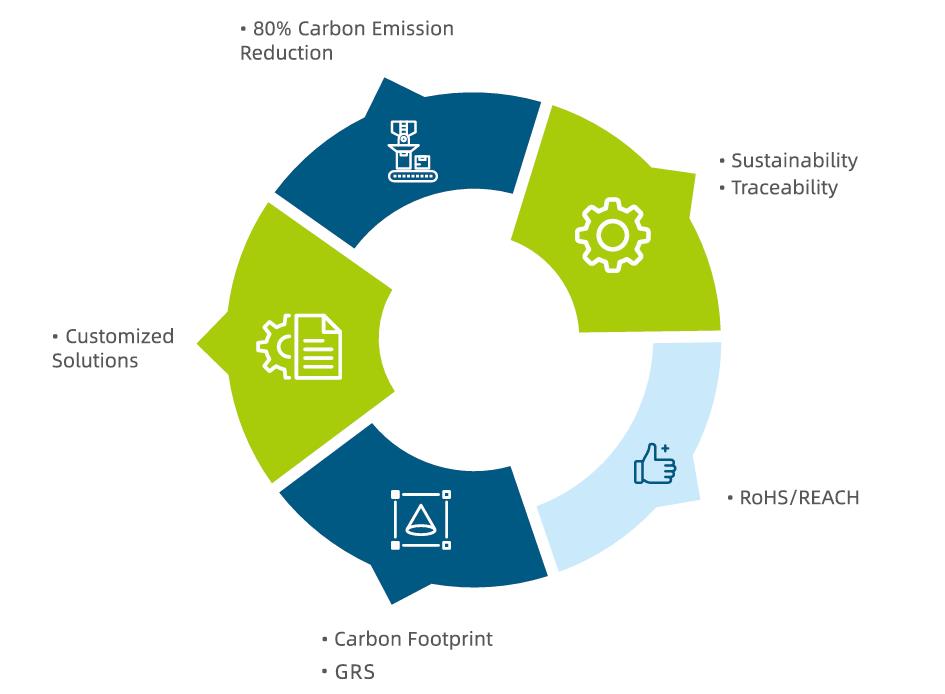
Recycled Polyetherimide (RIPEI® rPEI) is recycled form recycled products produced through pretreatment standardized granulation and other technological processes. According to different recycling sources and quality grades, special classification method, technologicalinnovation and high-guality automatic processing were applied to produce injection molding grade rPEl particles. The products are natural color with little vellow or brown, can meet the different application needs of customers, We also can provide all-round customized svstem solutions and innovative solutions according to the special reguirements of customers.
| Typical Grade | rPEI-106A | rPEI-106B | rPEI-108A | rPEI-108B |
|---|---|---|---|---|
| MFI, 337°C, 6.7Kg | 20 | 20 | 20 | 20 |
| IZOD Notched Impact Strength, KJ/m² | 5 | 5 | 5 | 5 |
| Tensile Strength, MPa | 100 | 95 | 100 | 90 |
| Flexual Strength, MPa | 150 | 145 | 150 | 120 |
| Appearance | Amber | Dark amber | Amber | Dark amber |
| Certification | GRS | GRS | GRS/UL 2809 | GRS/UL 2809 |
| Application | Compounding, Injection, Extrusion | Compounding, Injection, Extrusion | Compounding, Injection, Extrusion | Compounding, Injection, Extrusion |
| Carbon emissions ton CO2e | 0.8858(PCF C) | 0.8914 | 0.9423(PCF C) | 0.9502 |
Topcircle ,TcycleSP®,RIPEl,FreeCB02°( “Zero" Carbon Products)

The product be used in extrusion molding and injection molding. High grade products can be used to make various injection molded parts.


We offer a wide variety of materials, including general plastics, engineering plastics, and specialty plastics, covering almost all types of recycled polymers.

With a dedicated R&D team, we continuously innovate and develop high-performance, customized material solutions to meet diverse industry needs.

From research and testing to manufacturing and sales, we provide end-to-end solutions, streamlining the supply chain for our clients.

Our products promote low-carbon, circular economy practices,supporting global sustainability efforts with bio-based and degradable materials.
Sustainable low - carbon functional materials are applied across numerous critical areas. In the energy sector, they are pivotal. For instance, advanced photovoltaic materials with low - carbon manufacturing processes are used to construct more efficient solar panels. These materials enhance the conversion of sunlight into electricity, contributing to the expansion of renewable energy sources and reducing reliance on fossil fuels.
In the textile industry, sustainable low - carbon functional materials are making waves. Bio - based and recycled fibers are being used to create fabrics. These materials not only consume less energy during production but also have a lower environmental impact compared to traditional synthetic fibers. Moreover, some functional textiles made from these materials can regulate body temperature, repel water, or provide UV protection, all while maintaining a low - carbon footprint.
In the textile industry, sustainable low - carbon functional materials are making waves. Bio - based and recycled fibers are being used to create fabrics. These materials not only consume less energy during production but also have a lower environmental impact compared to traditional synthetic fibers. Moreover, some functional textiles made from these materials can regulate body temperature, repel water, or provide UV protection, all while maintaining a low - carbon footprint.


